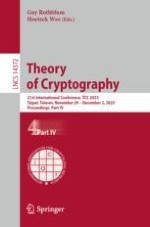The four-volume set LNCS 14369 until 14372 constitutes the refereed proceedings of the 21st International Conference on Theory of Cryptography, TCC 2023, held in Taipei, Taiwan, in November/December 2023. The total of 68 full papers presented in the proceedings was carefully reviewed and selected from 168 submissions. They focus on topics such as proofs and outsourcing; theoretical foundations; multi-party computation; encryption; secret sharing, PIR and memory checking; anonymity, surveillance and tampering; lower bounds; IOPs and succinctness; lattices; quantum cryptography; Byzantine agreement, consensus and composability.
